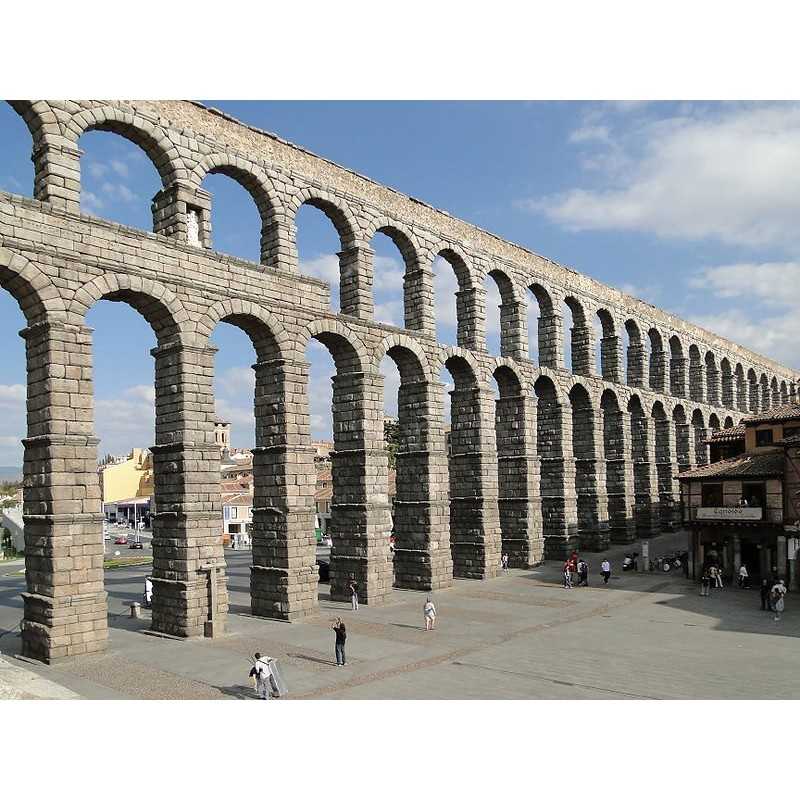




Our guided tour is a walk through the old city of Segovia, to learn about its history, to see its most important monuments (Aqueduct, Alcazar, Cathedral) and to enjoy its medieval atmosphere.
Length of the tour: 5 hours (half day), 8 hours (full day) since we leave until we return to Madrid.
In 1985, the old city of Segovia and its Aqueduct were declared World Heritage by UNESCO.
In our guided tour, we´ll walk through the old town of Segovia, admiring its old houses with facades decorated with engravings, and its monuments, from the Roman Aqueduct in Azoguejo Square, passing by the house of the Peaks, the monument to Juan Bravo, the House of the Fifteenth Century, the church of San Martin, the former prison (now the Public Library), the former synagogue (now Church and convent of Corpus Christi) to the Plaza Mayor, the Cathedral, the City Hall, the Juan Bravo theatre and the church of San Miguel, and from there, by the old quarter of the Canonries to the Alcazar. After the visit, return to Madrid.
This tour can be of 5 hours (since we leave until we return to Madrid) or 8 hours (since we leave until we return to Madrid). With the 8 hours tour, you can eat lunch in Segovia and visit one more monument that in the 5 hours tour.
The monuments to visit will be at customer's choice.
In the 5 hours visit, besides the walking tour, you can visit a monument inside (for example the Alcazar). In the 8 hours visit, you can visit both the Alcazar and the Cathedral inside.
Please, do not hesitate to ask for a budget: info@guiaoficialmadrid.com
Major monuments of Segovia:
The Aqueduct of Segovia, located in the emblematic Azoguejo square, is the symbol of the city. Its exact date of construction is unknown, it was built some time around the late first century or early second century, and it is the most important Roman civil engineering work in Spain. Built with about 25,000 granite blocks, put together without any mortar, it has a length of 818 meters, consists of more than 170 arches and measures 29 meters at its top, as it reaches the Azoguejo square.
The Alcazar, the royal palace located on top of a rock between the rivers Eresma and Clamores, appears first documented in 1122, although it may exist in earlier time. It was one of the favorite residences of the kings of Castile, built in the transition from Romanesque to Gothic, and decorated inside in moorish "Mudejar" Style. The building is articulated by two patios and has two towers, the Keep and John II. It was a favorite residence of Alfonso X the Wise and Henry IV, and Isabella the Catholic left from it to be crowned Queen of Castile in the main square. Devastated by fire in 1862, it was later rebuilt. Now it houses the General Military archive of Segovia and the museum of the Royal School of Artillery, managed by the Trustees of the Alcazar.
The Cathedral of Santa Maria is the last Gothic cathedral built in Spain and is known as "The Lady of spanish Cathedrals". It preserves the former cloister of the old cathedral, located opposite the castle and destroyed during the War of the Communities in 1520. Its architects were John and Rodrigo Gil de Hontañón, and other masters of Spanish architecture. It was consecrated in 1768 and its dimensions are: 105 meters long, 50 meters wide and 33 meters high in the nave. It has 18 chapels and three entrances: the Atonement, San Frutos and San Geroteo, first bishop of the diocese.
The walls of Segovia existed when Alfonso VI of Castile took the city to the Arabs, they had a perimeter of 3 kilometers, eighty towers, five doors and several gates. They were built mainly with granite blocks, but also reused gravestones of the Roman necropolis. The wall runs along the old city, and currently maintains three doors: San Cebrian, of great austerity, Saint James, Moorish-looking, and San Andres, gateway to the Jewish quarter.
The city has many important Romanesque churches of both stone and brick, which include San Esteban, San Millan, San Martin, the Holy Trinity, San Andres, San Clemente, Santos Justo y Pastor, Vera Cruz, San Salvador and others. It also has many convents and monasteries as San Antonio el Real, el Parral Monastery or San Vicente el Real.